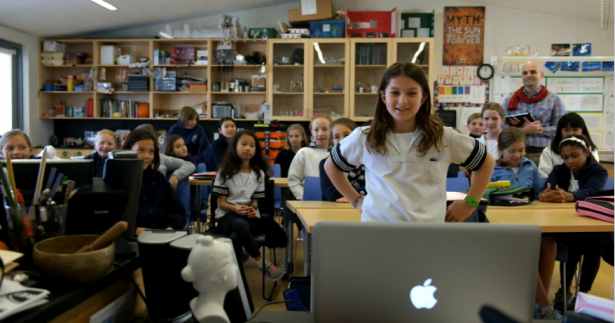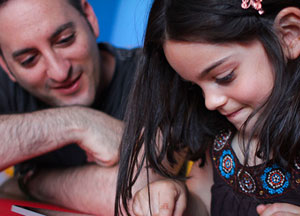When twelve-year-old Amy O’Toole spoke at TED last fall, she took the stage as one of the youngest people ever to have published a peer-reviewed science article. Amy’s inspiring article, which she wrote with her classmates as part of a playful participatory science program, is perhaps the only peer-reviewed science article to begin “Once Upon a Time”; it is both good science and a good story. As Amy’s article and TED talk show, play helps students learn science, and storytelling can help them share it.
With powerful new tools at our fingertips, we can connect our classrooms with the real world in ways that empower every student to be like Amy. Whether students are writing peer-reviewed science reports, chatting with NASA astronauts, publishing six-word memoirs on Twitter, or collaborating virtually to direct their own version of a Shakespeare play, connected classrooms enable students to learn and share with the whole world.
This fall, inspired by Amy’s talk, I worked with two elementary school educators to connect their classrooms using Toontastic, an iPad app for creating and sharing animated cartoons. Using Toontastic’s School Edition, students created science cartoons and conducted real-world peer review. We wanted to see how connecting classrooms through sharing science cartoons would reinforce students’ learning goals and increase their engagement. This is the story of what we learned from OUR experiment, along with resources for setting up your own collaboration in science, math, creative writing, or any other subject.
STEP 1: Create a Connection
Project Pen Pal was a collaboration between two amazing teachers, Leah Lacrosse and Mike Harms, and their students over two thousand miles apart. Leah teaches fifth-grade science at Woodlands Intermediate School in Huron, Ohio. Her students tackled a NASA engineering challenge: prototype robotic arms with using cardboard, rubber bands, string, and tape. Mike teaches fifth-grade science at Burkes School in San Francisco, California. His students photographed objects such as combs, zippers, and pencil cases under the microscope, and constructed collages from images at different levels of magnification. While Leah and Mike used different tools, they shared the same learning goal — to teach their students about the scientific process — which made them great candidates for collaboration.
STEP 2: Student Introductions
Working in small groups, students in each classroom exchanged cartoons asynchronously over two months. First, they introduced themselves to their peers. After exchanging get-to-know-you cartoons, the students then set out to create a second round of cartoons about their science projects. Toontastic’s Story Arc helps student break their cartoons into scenes, and we encouraged students to treat these scenes as different sections of a scientific report. Mike’s students sent reports about their magnified objects to Leah’s students, while Leah’s students sent detailed instructions for building robotic hands and shared some instructive misfires that occurred along the way. Here are two of our favorite cartoons:
STEP 3: Conduct Peer Review
After each group watched their pen pals’ cartoons, we asked them to critique each other’s work. Since the robot and microscope activities were different, we scaffolded students’ feedback by asking them to consider science ideas like hypothesis, process, and results. It worked out beautifully. Mike’s students asked their pen pals about the process of building robotic hands and suggested ways for them to clarify their cartoons. Leah’s students asked their pen pals to think more deeply about their magnified objects. Why, for instance, did a butterfly wing look like a piece of snakeskin?
We had planned for groups to revise their cartoons based on this feedback, but two new and exciting developments caused us to change course. First, Leah’s students loved the idea of creating microscope collages so much that they decided to undertake their own microscope project – with moon rocks! Second, Mike’s students made great progress on their collages and had much more to share. We challenged students to create entirely new cartoons.
STEP 4: Final Presentations
In the final part of the collaboration, Leah’s students produced cartoons about their moon rock investigations, while Mike’s students showed off their personal collages (and some of their friends’).
As students finished, they gathered for a real-time Google Hangout. Meeting synchronously for the first time, students traded ideas and app suggestions, reflected on what it felt like to learn two subjects at once, and wished each other a well-deserved school vacation.

Results
With Project Pen Pal we wanted to see how connecting two science classrooms through sharing science cartoons would reinforce students’ learning goals and increase students’ engagement with their curriculum. Armed with Toontastic’s Story Arc – a guide to putting together different kinds of scenes into a cartoon – students had a ready-made structure for organizing their questions, hypotheses, observations, and results, and even their peer critiques. “I cannot think of a better tool to get kids to write about science,” Leah said. “It takes a little bit longer, but the time that you spend pays off later.” Mike added that throughout the project, “I saw my students grow as communicators, leaders, and shared decision makers.” In addition to growing in this way, Leah’s students were so intrigued by their partners’ work that they asked their teacher to add a microscope unit to their curriculum.
There were the inevitable challenges of coordinating busy schedules and getting up to speed on unfamiliar curriculum. Yet because Leah and Mike shared the goal of teaching their students about the scientific method, the differences in their curricula became an asset. Their students had the opportunity to learn about two subjects at once, and to ponder what connected them, like the ideas of structure and function.
Most exciting, we realized this collaboration could work for any subject, not only science. With Toontastic, students could create book reports, display art projects, or record fieldwork. Creative students will find new uses we haven’t even imagined yet.
Conclusion: “Play with a Focus”
Students not only learned about the scientific process, but also saw how sharing playful science cartoons can create new learning relationships (and be lots of fun!).
“We’re always trying to justify how I use the iPads, because to outsiders, it looks like you’re just playing,” Leah said. “And this is play with a focus. It’s a phenomenal tool.”
Amy O’Toole had better watch out – and so should your students, because…
Resources to Connect YOUR Classroom
Are you ready to try collaboration in YOUR classroom? Explore these resources:
- Download a step-by-step Classroom Guide
- Find collaborators
- Download a Connected Educator starter kit
- Browse Edutopia’s Connected Educator tips
- Browse these Connected Educator Month resources
- Learn about digital storytelling
- Download Toontastic: School Edition for your classroom
Have fun!
 Joel Knopf is a Bay Area-based writer and graduate of Harvard Law School and Yale University. His interest in how new digital tools help people share stories, make music, and learn inspired his work with Launchpad Toys on Project Pen Pal. Find out more by contacting him on Twitter or visiting his website www.meltsinyourmind.com.
Joel Knopf is a Bay Area-based writer and graduate of Harvard Law School and Yale University. His interest in how new digital tools help people share stories, make music, and learn inspired his work with Launchpad Toys on Project Pen Pal. Find out more by contacting him on Twitter or visiting his website www.meltsinyourmind.com.



